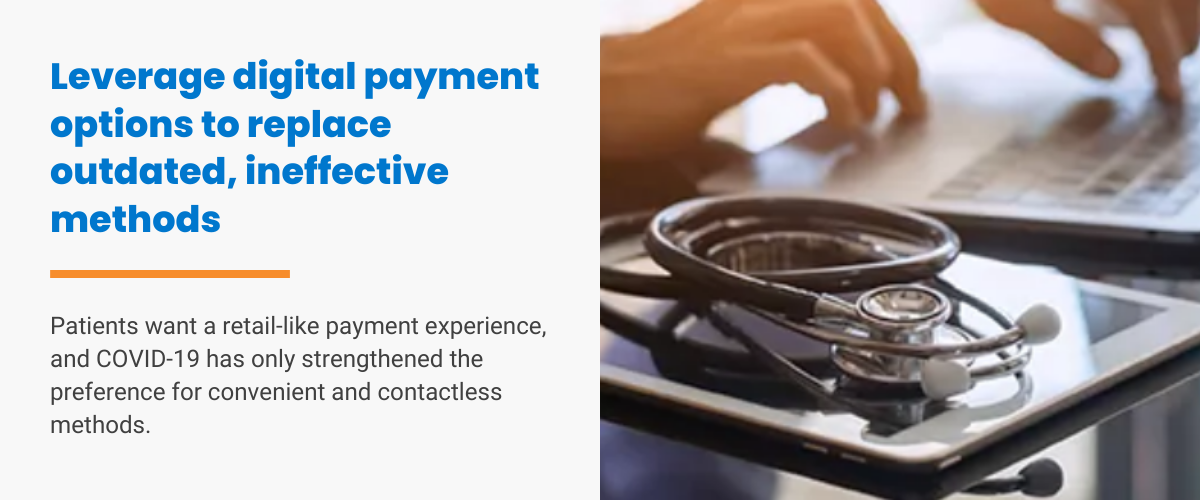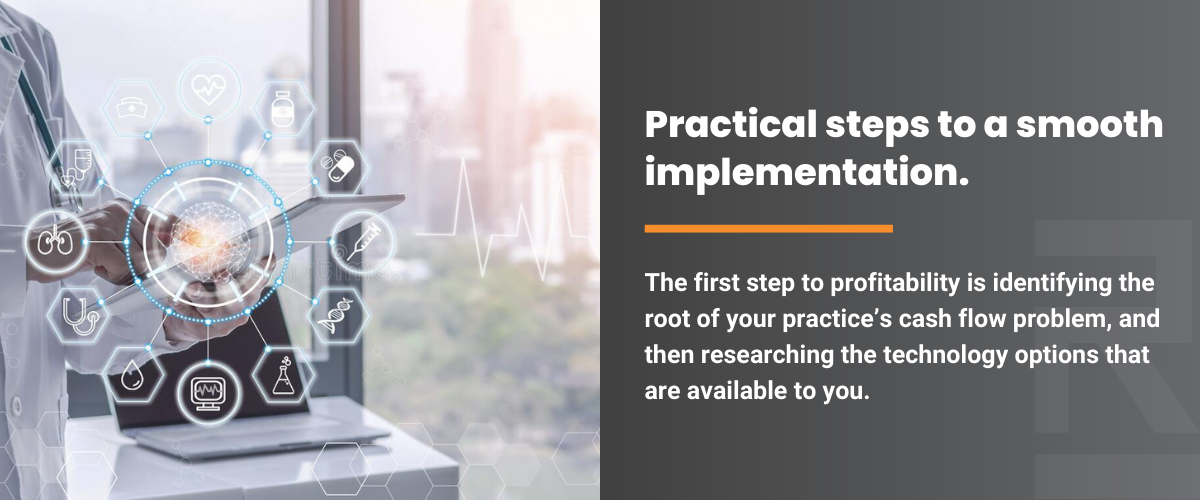Ophthalmology practices and clinics are gradually rebounding from the revenue impacts of 2020 resulting from temporary clinic closures, furloughs, increased PPE costs, and postponement of ocular surgeries and elective procedures. On top of the impacts brought on this past year is a problem that already existed in a critical part of the revenue cycle: capturing patient payments.
In addition to delivering patient care, revenue cycle management and timely patient payments are often top concerns for ophthalmologists. Reimbursement for care is declining while patients’ out-of-pocket responsibility increases, and providers are tasked with finding effective ways to provide affordable payment options for uninsured and underinsured populations.
The ophthalmology care sector is a pioneer of cutting-edge technology, therapies, and surgical techniques, but its payment and revenue cycle systems are often lagging. Digital payment technology can help ophthalmologists alleviate the problem in their practices of outstanding accounts receivables by making it easier for patients to pay, extending additional payment options, and automating payment processes in the office.
Despite the benefits, some groups are hesitant to move forward with new technology implementation. This whitepaper brings you the top three ways that technology can help improve cash flow for ophthalmology practices of all sizes, including insights and firsthand experiences from healthcare business professionals who have recently completed a technology transformation, and practical advice for successful technology implementation.
Three Ways Ophthalmology Practices Can Optimize Cash Flow Through Payment Technology
1. Leverage digital payment options to replace outdated, ineffective methods.
Patients want a retail-like payment experience, and COVID-19 has only strengthened the preference for convenient and contactless methods. Despite offering world-class ophthalmological care, many offices are still years behind offering the latest payment options.
The traditional cycle of mailed bills, checks, and credit card numbers read over the phone is inefficient, and it is certainly not best practice for safety and security. Not only is this inconvenient for patients, it’s also bad for providers who are unlikely to receive timely payments, and for their staff who spend a significant portion of their time chasing the payments. The revenue cycle stalls at accounts receivables, and unfortunately, this is not an anomaly for healthcare providers.
Adriana Weicht, Chief Operating Officer of Innovative Healthcare Business Solutions, recognized a problem in one of her care groups that is familiar to many providers: the amount of payments that patients owed continued to rise above incoming cash flow. Weicht saw the opportunity that digital options could create by allowing patients to manage their own finances, realizing, “If we wanted the patients to make those payments, we needed to make it as easy as possible for them.”
Leveraging the latest digital payment options means that instead of mailed statements and phone calls, patients can pay their bills online using a computer, tablet, or mobile device when it is most convenient for them in their day.
With Text-to-Pay technology, offices can text patients their balance details with a link to pay directly from their smartphones. Giving patients the convenient payment tools that they want and expect greatly increases the chances of receiving timely payment.

2. Use Card on File and payment plan technology to stabilize cash flow.
Storing patients’ preferred card information through secure card-on-file technology is a practical way that providers can ensure that they receive payment for the services rendered. Card on File can also help facilitate a simpler in-person check-out process.
Payment plan technology – linked to a debit, HSA/FSA, or credit card on file, gives ophthalmologists a practical solution for working with patients who are unable to, or prefer not to, make a lumpsum payment. According to a recent study, 54% of patients said they would store their preferred payment details with their provider(s), and two out of three patients said they want access to payment plans.1
Payment plans allow patients to afford care, and providers to receive consistent incoming payments instead of waiting on a large payment that might not come.
Offering payment plans can make out-of-pocket costs more manageable and may make it possible for patients to start treatment that they might otherwise be hesitant to begin, increase satisfaction and loyalty, and create a better business model for providers. Using technology with built-in payment plan capabilities means that providers can offer flexible terms to their patients without splitting revenue with a third-party billing or collection company.
Make it a part of your office flow to talk to patients about what the payment process will look like and utilize convenient communication tools in front-office technology to send text message communications to patients with details about upcoming payments and balances.
3. Automate payment posting to increase office efficiency and reduce error.
With more payments coming in, it is imperative to invest in a revenue cycle tool that will interface with existing practice management systems and automatically post payments to the patient ledger. Doing so frees office staff up for other, revenue-building activities and saves them time and bandwidth in their days. Carroll Papajohn, the Executive Director of a care center, has seen additional benefits of automatic payment posting, explaining that the technology, “Takes a manual, very tiresome, and because there are humans involved – error-prone – process and automates it…that’s going to free up time for the billing staff to be able to focus on other, more revenue-generating activities.” Having an automatic way to sync payments between systems also removes the possibility of error, ultimately meaning more accurate reconciliation and revenue numbers and higher patient satisfaction because of up-to-date information. Papajohn says he didn’t realize, “How much of a morale boost it would be to take a manual process and automate it.” Weicht echoes this sentiment, saying that, “The staff is just so happy that we eliminated a step for them having to post those payments manually.
Practical Steps to a Smooth Implementation
The first step to profitability is identifying the root of your practice’s cash flow problem, and then researching the technology options that are available to you. When making a list of what would most benefit the practices that she was optimizing, Weicht didn’t settle, “We looked for a solution that interfaced with our practice management system and that could also help us speed up the check-in process, and we also wanted patients to be able to make payments on an online portal. So we were looking for an all-in-one solution, and that’s really what we went after.”
Beyond the solution itself, learn about the implementation process and the level of support that the technology vendor provides with set up, troubleshooting, and training. The right technology provider will come alongside your organization as a partner in the implementation process and move the process along smoothly and efficiently.

Plan, share, and continue to communicate along the way.
Weicht had the significant role of overseeing the implementation process for 100+ healthcare offices under an umbrella group. She worked with the chosen technology vendor to come up with an implementation plan that was proven to work effectively based on their experience and that would also make their care centers comfortable with the process. “When we decided to make this transition, we needed to make sure this would be an easy transition across all of the care centers,” she said. “I decided to split the group into smaller groups of four care centers at a time.” The implementation team used a three-part implementation process, all done remotely through calls, to break the process up into manageable pieces and to allow time for questions and troubleshooting along the way.
Finding the right time for a new technology implementation at a busy ophthalmology care center can be a challenge, but setting your group up for revenue success and improved workflows far outweighs any inconvenience.
A complete healthcare technology solution for ophthalmology.
With customized solutions for the ophthalmology specialty, Rectangle Health has been providing healthcare payment technology to providers for over 25 years. Our Practice Management Bridge® platform offers all-encompassing payment tools, including online payments, Text-to-Pay, and flexible payment plans, and office efficiency tools, such as customizable text messages, that help offices easily communicate with patients, receive more payments, and operate more smoothly.
With our many years of experience, Rectangle Health has smooth and efficient implementation down to an art and knows how to work effectively with ophthalmology offices of all sizes.
“I can’t say enough about the Rectangle Health team. They have been there through all of it, and I think that has made the difference… It’s really been smooth sailing for such a large group,” Weicht recounts.
Papajohn has had a similarly positive experience at the care center level, sharing that, “It’s going very well. Our structure is complex where we have to set up multiple processors within the same location. Rectangle Health was very adaptable and worked diligently to get the merchant IDs set up… They’ve been very helpful with PCI compliance. All in all, very positive experience with the Rectangle Health team.”



